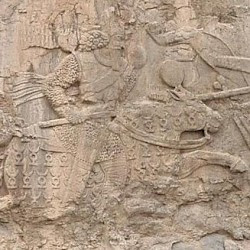Jona Lendering
Jona Lendering read history at Leiden University (MA 1993), specialized in Mediterranean culture at the Amsterdam Free University (MA 1996), and worked at excavations in Holland (Riethoven) and Greece (Halos). After teaching historical theory and ancient history at the Free University for several years, he was one of the founders of a school for history teaching, Livius Onderwijs. Born in Amsterdam, it has now spread to auxiliary locations in Bussum, Dronten, Gouda, Haarlem, Hoorn, Schagen, Zaanstad, and Zoetermeer. As of 2013, Livius Onderwijs has eight teachers, about 500-600 students a year, and offers tours to countries like Italy, Turkey, Iran, and Lebanon. The field trips help to etch into the students' minds some of what they've learned at the school.
Because history is for a large part telling a story, something you do best in your own language, Lendering prefers to publish in Dutch journals. However, he has contributed to the Bryn Mawr Classical Review and Ancient Warfare, while he is the founder of Ancient History Magazine. He is also the publisher and editor of the on-line publication of the Babylonian Chronicles of the Hellenistic Period, a set of important cuneiform sources for the history of the Seleucid and Parthian Near East, transcribed, translated and commented on by Bert van der Spek of the Free University Amsterdam and Irving Finkel of the British Museum. A publication as book is in preparation.
Lendering has written several books and maintains a blog in Dutch. He is the author of several books, including Edge of Empire and Consensus and Crises. For the Livius website, which has received several awards, he collaborates closely with Bill Thayer of LacusCurtius. Lendering is also the webmaster of two daily blogs, the MainzerBeobachter.com and Grondslagen.net.
There are 9380 items in Jona Lendering:

Firuzabad, Relief 1, Scene 2, Shapur unseats Artabanus |
Firuzabad, Relief I
Ardašir Khureh ("fame of Ardašir): Sasanian city in Persis, modern Firuzabad. Except for the city, there is a castle, a palace, a large relief celebrating Ardašir's victories (discussed on this page), and a small relief commemorating his investiture. Firuzabad, Relief 1 …Firuzabad, Relief II
Ardašir Khureh ("fame of Ardašir): Sasanian city in Persis, modern Firuzabad. Except for the city, there is a castle, a palace, a large relief celebrating Ardašir's victories, and a small relief commemorating his investiture (discussed on this page). The second Sasanian rock relief near Firuzabad is better visible than the first one: it…Fiscus
FiscusFiscus Judaicus
Fiscus Judaicus ("Jewish tax"): a tax that the Jews had to pay to the temple of the Roman supreme god Jupiter Capitolinus after the destruction of their own temple in 70 CE. …Flash flood
Flash flood: the seasonal flood in a wadi. A flash flood in Bani Walid A wadi is a river in an arid…Flavians
Flavian dynasty: second imperial dynasty of Rome, ruling from 69 until 96. Vespasian (Hippo Regius) The three Flavian emperors were Vespasian Titus Domitian The general prosperity…Titus Flavius Sulpicianus
Titus Flavius Sulpicianus (second half second century): Roman senator, candidate to the imperial throne in 193. Roman man c.170-190 CE Titus Flavius…Flevum (Velsen?)
Flevum: Roman naval base among the Frisians, probably identical to Velsen in the Netherlands.Velsen-1 Velsen I (design Graham Sumner) Like Fectio/Vechten, Velsen…

The Flood Tablet |
The Great Flood: Genesis' two sources
The Great Flood: mythological story about a great destruction that once befell the earth. There are several variants; the Biblical version is the most famous. The possibility that there is a historical event behind the story (a local flood in southern Babylonia in the…The Great Flood: Sumerian version
The Great Flood: mythological story about a great destruction that once befell the earth. There are several variants; the Biblical version is the most famous. The possibility that there is a historical event behind the story (a local flood in…